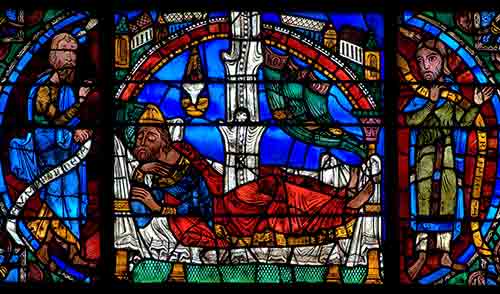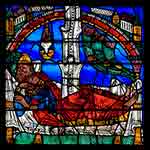
and Jesse the father of King David. And David was the father of Solomon by the wife of Uriah (Matthew 1:6)
This is the fifth post in a series – you can begin here:
Matthew in Slow Motion 1
Matthew in Slow Motion 2
Matthew in Slow Motion 3
Matthew in Slow Motion 4
As this year the Sunday Gospel readings’ focus is on St Matthew’s Gospel, I thought I’d start some of my personal study and Lectio Divina with that Gospel. [NB. I am using ‘Matthew’ as a convenient term for the author of the first Gospel in the order of the Christian canon].
A shoot shall come out from the stock of Jesse, and a branch shall grow out of his roots. The spirit of the Lord shall rest on him… (do read the rest)
The above (as you read on into Chapter 11 of Isaiah) can clearly be read as a prophecy of the messiah – and so Matthew, understandably, wants to locate Jesus as fulfilling this and growing on Jesse’s family tree.
There are lots of images of the family tree of Jesus with the trunk coming out of the loins of Jesse (I think the Chartres window, above, is the oldest glass version). Often the image has been altered from its R18 potential to have the trunk come from Jesse’s side rather than his loins!
Now we come to the next woman in Matthew’s list. In Matthew’s genealogy, we have had:
Tamar – who acted like a prostitute and became pregnant after having sex with her father-in-law. Both of them, according to Lev 20:12, should have been put to death – “they have committed perversion”.
Rahab – the foreign prostitute, whose presence in the list is another clear transgression of God’s laws.
Ruth – the Moabite (Moabites, I remind you, originate from Noah having sex with his daughter near Sodom and Gomorah). And, according to Deuteronomy 23:3, this means that her descendent, King David, is unable to be part of God’s people let alone their king.
The fourth woman is not even named: “the wife of Uriah”. It’s not like Matthew forgot her name (Bathsheba). It is as if he is rubbing in the scandal: David, when, like other kings, he should have been out leading his troops, instead was lounging about at home committing adultery with the wife of one of his soldiers (talk about power differential!). Having sought to trick Uriah into thinking the child was Uriah’s, he finally has Uriah killed instead. The book of Chronicles, writing about the same period, sanitises the scandal by simply omitting it.
On the other hand, as if to rub in the scandal of David, 2 Samuel follows the story, of David’s adultery and having Uriah killed, by the story of David’s son, Amnon, raping his sister, Tamar. Like father, like son.
Matthew does not follow the Chronicles’ idealising-of-David version (remember that 1 Chronicles 11:41 does mention Uriah the Hittite – but David’s adultery, Uriah’s death, and how Bathsheba came to be David’s wife are glossed over in this whitewashing). I’ve already noted that Matthew is following the genealogy in Chronicles. So, seeing that Matthew does not follow Chronicles in this particular case, when normally, for his genealogy, he is – this should make us sit up and take note.
Matthew stresses the dysfunctional family background list of Jesus by underlining that it was “the wife of Uriah” through whom he is tracing this genealogy. As I have said, Matthew in his overture, even in the context of Jesus’ roots in Israel, is highlighting his connection with foreigners and his connection with sinners and the dysfunctional.
To be continued…
If you appreciated this post, consider liking the liturgy facebook page, using the RSS feed, and/or signing up for a not-very-often email, …



